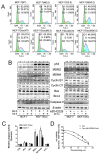Targeting P-glycoprotein function, p53 and energy metabolism: Combination of metformin and 2-deoxyglucose reverses the multidrug resistance of MCF-7/Dox cells to doxorubicin
- PMID: 28052008
- PMCID: PMC5352427
- DOI: 10.18632/oncotarget.14373
Targeting P-glycoprotein function, p53 and energy metabolism: Combination of metformin and 2-deoxyglucose reverses the multidrug resistance of MCF-7/Dox cells to doxorubicin
Abstract
Multidrug resistance(MDR) is a major obstacle to efficiency of breast cancer chemotherapy. We investigated whether combination of metformin and 2-deoxyglucose reverses MDR of MCF-7/Dox cells and tried to elucidate the possible mechanisms. The combination of metformin and 2-deoxyglucose selectively enhanced cytotoxicity of doxorubicin against MCF-7/Dox cells. Combination of the two drugs resumed p53 function via inhibiting overexpression of murine doubleminute 2(MDM2) and murine doubleminute 4(MDM4) leading to G2/M arrest and apoptosis in MCF-7/Dox cells. Combination of the two drugs had no effect on P-glycoprotein mRNA expression and P-glycoprotein ATPase activity but increased doxorubicin accumulation in MCF-7/Dox cells. The increased doxorubicin accumulation maybe associate with metabolic stress. Combination of metformin and 2-deoxyglucose initiated a strong metabolic stress in MCF-7/Dox cells via inhibiting glucose uptake, lactate, fatty acid, ATP production and protein kinase B(AKT)/ mammalian target of rapamycin(mTOR) pathway. Taken together, combination of metformin and 2-deoxyglucose reverses MDR of MCF-7/Dox cells by recovering p53 function and increasing doxorubicin accumulation. Furthermore, doxorubicin selectively increases MCF-7/Dox apoptosis via aggravating metabolic stress induced by metformin plus 2-deoxyglucose. The mutually reinforcing effect made the combination of metformin and 2DG had a better effect on reversing MDR.
Keywords: P-glycoprotein; energy metabolism; multidrug resistance; p53.
Conflict of interest statement
The authors declare no financial or other conflict of interest with regard to this work.
Figures





Similar articles
-
Targeting P-glycoprotein expression and cancer cell energy metabolism: combination of metformin and 2-deoxyglucose reverses the multidrug resistance of K562/Dox cells to doxorubicin.Tumour Biol. 2016 Jul;37(7):8587-97. doi: 10.1007/s13277-015-4478-8. Epub 2016 Jan 6. Tumour Biol. 2016. PMID: 26733176
-
Reversal of P-glycoprotein-mediated multidrug resistance is induced by saikosaponin D in breast cancer MCF-7/adriamycin cells.Pathol Res Pract. 2017 Jul;213(7):848-853. doi: 10.1016/j.prp.2017.01.022. Epub 2017 Feb 3. Pathol Res Pract. 2017. PMID: 28554760
-
Schisandrin A reverses doxorubicin-resistant human breast cancer cell line by the inhibition of P65 and Stat3 phosphorylation.Breast Cancer. 2018 Mar;25(2):233-242. doi: 10.1007/s12282-017-0821-9. Epub 2017 Nov 27. Breast Cancer. 2018. PMID: 29181822
-
Molecular mechanisms for tumour resistance to chemotherapy.Clin Exp Pharmacol Physiol. 2016 Aug;43(8):723-37. doi: 10.1111/1440-1681.12581. Clin Exp Pharmacol Physiol. 2016. PMID: 27097837 Review.
-
Modulatory effects of miRNAs in doxorubicin resistance: A mechanistic view.Funct Integr Genomics. 2024 Sep 2;24(5):150. doi: 10.1007/s10142-024-01431-x. Funct Integr Genomics. 2024. PMID: 39222264 Review.
Cited by
-
Baicalein sensitizes triple negative breast cancer MDA-MB-231 cells to doxorubicin via autophagy-mediated down-regulation of CDK1.Mol Cell Biochem. 2023 Jul;478(7):1519-1531. doi: 10.1007/s11010-022-04597-9. Epub 2022 Nov 21. Mol Cell Biochem. 2023. PMID: 36413334
-
Sorcin: a novel potential target in therapies of cancers.Cancer Manag Res. 2019 Aug 5;11:7327-7336. doi: 10.2147/CMAR.S208677. eCollection 2019. Cancer Manag Res. 2019. PMID: 31496794 Free PMC article.
-
Metformin: The Answer to Cancer in a Flower? Current Knowledge and Future Prospects of Metformin as an Anti-Cancer Agent in Breast Cancer.Biomolecules. 2019 Dec 9;9(12):846. doi: 10.3390/biom9120846. Biomolecules. 2019. PMID: 31835318 Free PMC article. Review.
-
Metformin partially reverses the carboplatin-resistance in NSCLC by inhibiting glucose metabolism.Oncotarget. 2017 Sep 6;8(43):75206-75216. doi: 10.18632/oncotarget.20663. eCollection 2017 Sep 26. Oncotarget. 2017. PMID: 29088858 Free PMC article.
-
Reversal of obesity-driven aggressiveness of endometrial cancer by metformin.Am J Cancer Res. 2019 Oct 1;9(10):2170-2193. eCollection 2019. Am J Cancer Res. 2019. PMID: 31720081 Free PMC article.
References
MeSH terms
Substances
LinkOut - more resources
Full Text Sources
Other Literature Sources
Medical
Research Materials
Miscellaneous

